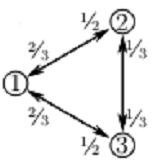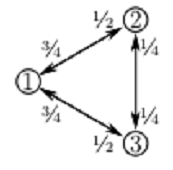Reference no: EM132315218
Assignment -
Consider a graph G with adjacency matrix A and a random walk on G with transition matrix T, where

Now our random walker slightly favours vertex 1 over the other two, with neither of these other two being favoured over the other.
So the steady state vector should have the form S = .
.
But what should the probabilities p and q be? Can you guess?
To find p and q we could use the method we used when investigating Markov chains earlier in the course.
That is, we could use the computer to solve the system of linear equations represented by the matrix equation (T' - I)S = 0 modified by replacing all entries in the last row of both T - I and 0 by 1.
However, in this case the equations boil down to: -p + 4/3q = 0 and p + 2q = 1.

On average, our walker spends 40% of the time at vertex 1 and 30% at each of the other two vertices. Is that what you guessed?
The steady state vector is S = . As you can check, T'S = S.
. As you can check, T'S = S.
Please show the solution step-by-step.
For this question, working is not required and will not be marked.
Early in Section D3 of the course we investigated examples of random walks on a 3-vertex digraph under various sets of transition probabilities. This question continues and extends that investigation. The diagram at right shows the transition probabilities for Example 3 in the notes.

First consider random walks of length 4 starting at 2:
(a) The number of different such walks is.
(b) The number of these walks that end up at 1 is.
(c) The probability that such a walk ends at 1 is. (Give an exact fraction)
Hint: You can either add the probabilities of taking each of the routes you counted for (b), or you can power up the transition matrix using Wolfram Alpha. Doing it both ways is a good check!
Now consider what happens to Example in the notes if vertex 1 is made more 'attractive' by increasing the probability of transition into it from 2/3 to 3/4 (and making the necessary consequential changes to other probabilities - see diagram at left.) As a result of this change we might expect that the probability calculated for part (c) should increase.

(d) With the new transition probabilities the probability that a length-4 random walk from (2) ends at 1 is. (Give an exact fraction).
(e) Compared to the corresponding probability (c) using the original transition probabilities, this new probability (d) is (circle)
HIGHER / LOWER / THE SAME
As a result of the changed transition probabilities we might also expect that, in the long term, the proportion of time that a random walker spends at vertex 0 will increase, but if so, by how much? Use hand calculations or computer to find out:
(f) The proportion increases from 4/10 to ____.
Instructions: Math Random Walks topic - Handwritten Solution Required.
Attachment:- Assignment File.rar